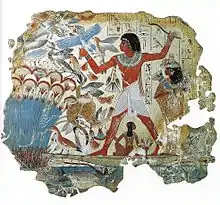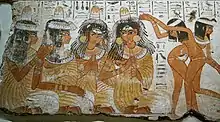| Tomb of Nebamun | |
|---|---|
 Fowling scene | |
| Period/culture | 18th Dynasty |
| Discovered | 1820 Theban Necropolis |
| Discovered by | Giovanni (Yanni) d'Athanasi |
| Present location | British Museum, London |
| www | |
The lost Tomb of Nebamun was an ancient Egyptian tomb from the Eighteenth Dynasty located in the Theban Necropolis located on the west bank of the Nile at Thebes (present-day Luxor) in Egypt.[1] The tomb was the source of a number of famous decorated tomb scenes that are currently on display in the British Museum, London.[1][2]
The location of the tomb was not revealed at the time of its discovery in order to maintain secrecy during a period of competition between excavators, and was since lost. Scientific analysis in 2008-09 indicated the tomb's location in the vicinity of Dra' Abu el-Naga'.[3]
Discovery
Nebamun, who lived around 1350 BCE, was a middle-ranking official scribe and grain counter at the temple complex in Thebes. His tomb was discovered around 1820 by a young Greek, Giovanni ("Yanni") d'Athanasi,[4] who at the time was working for Henry Salt, the British Consul-General.[5][6]
Excavated artefacts
The tomb's plastered walls were richly and skilfully decorated with lively fresco paintings, depicting idealised views of Nebamun's life and activities. D'Athanasi and his workmen hacked out the pieces he wanted with knives, saws and crowbars.[7] Salt sold these works to the British Museum in 1821,[8] though some of the other fragments became located in Berlin and possibly Cairo. D'Athanasi later died in poverty without ever revealing the tomb's exact location.[4][9]
The best-known of the tomb's paintings include Nebamun fowl hunting in the marshes, dancing girls at a banquet, and a pond in a garden.[10] In 2009, the British Museum opened up a new gallery dedicated to the display of the restored eleven wall fragments from the tomb.[4][8] They have been described as the greatest paintings from ancient Egypt to have survived, and as one of the Museum's greatest treasures.[11][4][12]
Various scenes from the paintings have been used by artists in more modern times. Lawrence Alma-Tadema incorporated a scene of geese herding for a wall decoration depicted in his Joseph, Overseer of Pharaoh's Granary (1874), and Paul Gauguin used part of a banquet scene as a compositional plan in his Ta Matete (1892)[13]
Gallery
References
- 1 2 Salvat, Juan (1970). Historia del arte (in Spanish). Vol. Tomo 1. Barcelona: Salvat Editores, Sociedad Anónima. p. 320. ISBN 8434532433.
- ↑ "Egyptian life and death". The British Museum. Retrieved 25 April 2021.
- ↑ Rainer, Leslie. Reviewed Work: The Nebamun Wall Paintings: Conservation, Scientific Analysis and Display at the British Museum by Andrew Middleton, Ken Uprichard, Studies in Conservation, vol. 55, no. 2, [Taylor & Francis, Ltd., Maney Publishing, International Institute for Conservation of Historic and Artistic Works], 2010, pp. 146–148 "...the location of the tomb and any records about its excavation have been lost, apparently because of the secrecy with which early excavations in Egypt were conducted as excavators and collectors vied for their treasures.... Analytical results... indicate the location of the tomb-chapel of Nebamun in the vicinity of Dra Abu el-Naga."
- 1 2 3 4 McKie, Robin (4 January 2009). "Robin McKie on the mystery of ancient Egypt's Nebamun panels". the Guardian. Retrieved 25 April 2021.
These are the tomb paintings that once belonged to Nebamun, a court official who lived almost 3,500 years ago, and they are the greatest surviving paintings we have from ancient Egypt. Each was created for Nebamun by a painter as gifted as any of the Renaissance's finest artists, and they will be revealed to the public this month when the British Museum opens a special gallery dedicated to them, a 10-year project that has cost £1.5m to complete.... The man who discovered them was a Greek grave robber called Giovanni d'Athanasi, who dug them up in Thebes, as Luxor was then known, and then passed them on, via a collector, to the British Museum. However, in 1835 D'Athanasi fell out with curators over his finder's fee and refused to divulge the precise position of the tomb. He took his secret to the grave, dying a pauper in 1854 in Howland Street, a few minutes' walk from the museum. Ever since, archaeologists have searched in vain for the tomb of Nebamun and any treasures that it may still contain.
- ↑ "Giovanni d'Athanasi". www.britishmuseum.org. British Museum. Retrieved 25 April 2021.
- ↑ "Henry Salt". www.britishmuseum.org. British Museum. Retrieved 25 April 2021.
- ↑ Soueif, Ahdaf (10 January 2009). "Talking to the dead". Guardian. Retrieved 25 April 2021.
The Painted Tomb-Chapel of Neb-Amun does not shrink from describing how the men working for Henry Salt, the British consul, hacked into the paintings on the walls of Neb-Amun's burial-house "with knives and saws, outlining rectangular pieces that they then prised away ... with implements such as crow-bars". To carry off choice sections of a scene, whole contexts were destroyed. A young woman sits next to her friend at the party. The saw hacks through the crown of her head, severing the stalk of the lotus flower in her hair, cutting through the colourful headband, slicing down behind her ear then dividing into an inverted delta of damage, one branch snaking down her chest and arm, the other reaching across her shoulder to her friend. The brutality is astonishing.
- 1 2 "Nebamun goes hunting" (PDF). Cross-curricular literacy activities Key Stage 2 classroom resource. The British Museum. Retrieved 25 April 2021.
The painting featured in this literacy pack is one of eleven fragments of wall painting from Nebamun‟s tomb, acquired by the collector Henry Salt in about 1821, which are now housed in The British Museum.
- ↑ Parkinson 2008, p. 14.
- ↑ Parkinson 2008, p. 63.
- ↑ Parkinson 2008, p. 9.
- ↑ "New Egyptian Gallery at the British Museum". Retrieved 2008-09-01.
- ↑ Philip McCouat, "Lost masterpieces of ancient Egyptian art from the Nebamun tomb-chhapel" Journal of Art in Society http://artinsociety.com
- ↑ "Tomb-painting: Museum number EA37984". The British Museum. Retrieved 25 April 2021.
- ↑ "Tomb-painting: Museum number EA37983". The British Museum. Retrieved 24 April 2021.
Bibliography
- Parkinson, Richard B. (2008). The Painted Tomb Chapel of Nebamun. British Museum Press. p. 152. ISBN 9780714119793.




